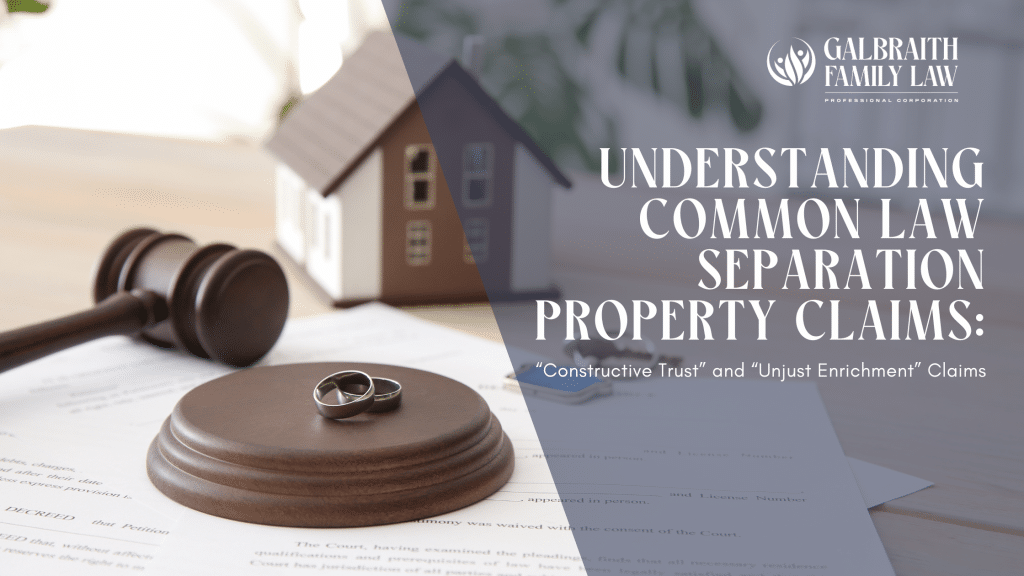[ad_1]
Have you ever ever heard of the phrases ‘constructive belief’ or ‘unjust enrichment’? These authorized phrases could sound difficult, however they’re vital ideas if you’re separating out of your common-law (single) companion. In frequent regulation relationships, you don’t mechanically share within the progress of your companion’s wealth such as you do while you’re married in Ontario. As an alternative, it’s a must to declare that it’s solely truthful that you simply get some compensation. You are able to do this by claiming {that a} constructive belief exists or that your companion can be unfairly enriched in case you’re not compensated.
A constructive belief is a solution to make issues truthful when one particular person has gained one thing of worth whereas the opposite particular person has misplaced one thing of worth. In these circumstances, the courtroom could order the one who has been enriched to surrender the profit they acquired or not less than share it with the opposite companion.
For instance, if a common-law companion has all of the property of their identify and their companion helped them purchase the property, they could have a declare. Possibly they contributed cash to it however didn’t put the asset of their identify. Possibly they supported their companion by offering care for his or her youngsters in order that their companion might construct wealth. Possibly they invested within the asset with their very own labor. One problem is to show that you simply helped purchase the asset and one other is figuring out how a lot you ought to be compensated. .
Unjust enrichment is just like constructive belief. It’s a authorized declare used when one particular person has been unfairly enriched on the expense of one other. The courtroom could order the one who has been enriched to pay again the worth of the profit they acquired, or a few of it.
So, how is the worth of a constructive belief or unjust enrichment declare decided? This could be a troublesome query to reply. In some circumstances, the courtroom could use professional proof to find out the worth of the acquired profit. In different circumstances, the courtroom could have a look at the circumstances of the couple to find out what appears truthful.
For instance, within the case of Tomek v. Zabukovec, the courtroom used the price strategy to find out the worth of the declare. Because of this the courtroom checked out the price of the land and the enhancements that had been made to it, to find out the worth of the declare.
In different circumstances, corresponding to Webb v Laforme, the courtroom estimated the worth of the declare based mostly on every particular person’s contribution to the asset. What did every particular person contribute in sweat fairness?
In Steele v. Doucet, the events labored collectively on the renovation designs, obtained quotes, and commenced the renovations in phases. The courtroom discovered that the overwhelming majority of the renovation work was carried out by Ms. Doucet’s father and his staff. Mr. Steele’s work contribution to the renovations was restricted to ripping out, cleansing, and different minor work. Absent proof from an professional, it was unattainable to inform the extent to which Mr. Steele’s personal efforts within the renovation work contributed to growing the worth of the property. No professional proof was referred to as so this declare failed. If an professional had testified as to vary of worth contributed by Mr. Steele, his declare could have succeeded.
In Karistinos v Karistinos, the respondent claimed he must be entitled to a credit score for the labour he personally provided in regards to the set up of wooden flooring and kitchen cupboards and miscellaneous associated work on the property. The respondent valued this work at $8,433.38. Nevertheless, the courtroom didn’t credit score the respondent with any quantity for so-called “sweat fairness”. The proof consisted of a valuation made by the respondent based mostly on consulting the web sites of the Ontario Contractors Affiliation and House Depot. The courtroom discovered that one thing greater than an web search by the respondent was essential to show this declare. For instance, an estimate from an unbiased contractor might have been obtained at little price. The courtroom refused to contemplate this declare on the only real foundation of the respondent’s personal estimate of worth.
In conclusion, constructive belief claims and unjust enrichment claims are vital authorized ideas which are used to make sure equity in authorized circumstances. The worth of those claims could be troublesome to find out, however the courtroom will use varied strategies to make sure a good final result. This weblog is predicated on the regulation in Ontario right now. It might not be the identical elsewhere.
In the event you really feel you may have a declare or your companion could also be searching for a declare in opposition to you, don’t try to signify your self. This space of the regulation is difficult. It’s essential to put ahead your finest case. At Galbraith Household Regulation, we might be with you each step of the way in which. We may also help.
[ad_2]
Source link

